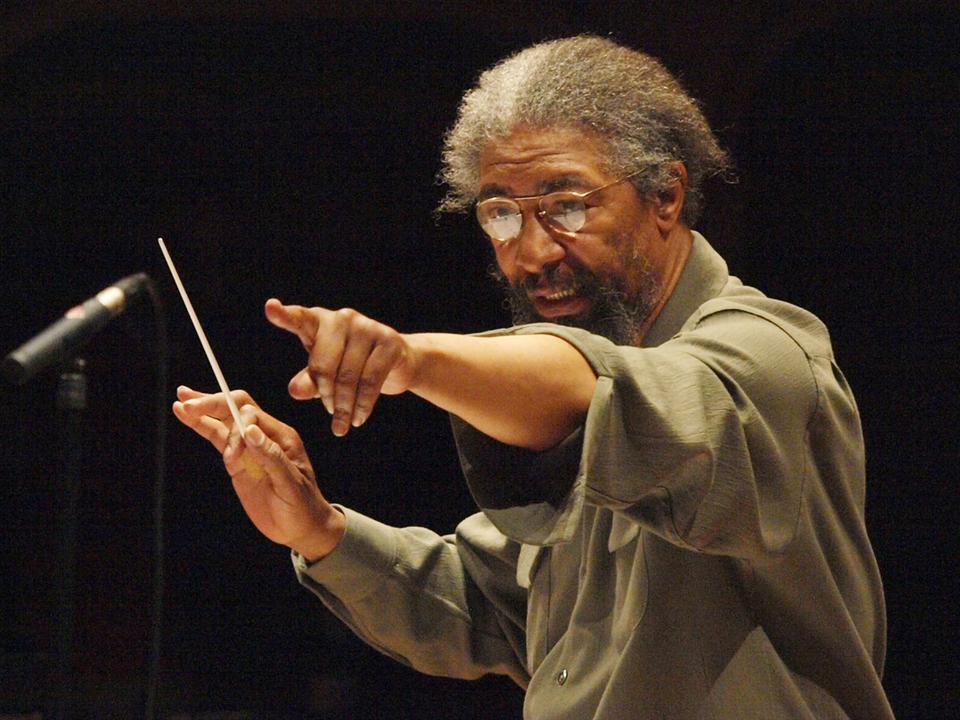
News
HMS Is Facing a Deficit. Under Trump, Some Fear It May Get Worse.

News
Cambridge Police Respond to Three Armed Robberies Over Holiday Weekend

News
What’s Next for Harvard’s Legacy of Slavery Initiative?

News
MassDOT Adds Unpopular Train Layover to Allston I-90 Project in Sudden Reversal

News
Denied Winter Campus Housing, International Students Scramble to Find Alternative Options
A Different Language for Improv Music

“You feel, when you play, like all the sounds are just passing through you. We’re equal afterwards. It’s this infinite music going past, and we’re trying to catch onto it,” said Aquiles Navarro, a trumpet player and a student at the New England Conservatory, as he held up two fingers like he was snatching something from the air. Navarro and 22 other NEC students had just performed a “Conduction”—a form of structured improvisation created by conductor and composer Lawrence D. “Butch” Morris—under Morris’ direction at the Institute of Contemporary Art last Friday.
The concert began with the musicians in a semicircle around Morris—the two violins closest to him, a guitar player on each side, and a xylophone-like vibraphone and a few drums towards the back. They had worked with Morris for three days in an intensive workshop during which he taught them the Conduction lexicon, a set of hand and baton gestures he has devised to direct music. The musicians learned how to interpret each of his signals—not as directions on exactly what to play, for no particular notes are ever specified, but simply as signals on when to play and how to move within the dynamic structure of the music. On the small, lit stage in the ICA, the musicians were all at the edges of their seats, rapt as Morris used his baton and body to speak to them.
That performance was the only night when this Conduction’s particular iteration—the contingent collision of sound in space—would ever be heard or made. This finitude seems important because the specificity of time and place could play a part in each of Morris’ creations. Speaking about the effect of circumstance in music, he said, “I think that even when you walk out the door you’re borrowing from the space around you. I don’t deal in chance and uncertainty. I deal in risk.”
Morris began the first piece with his hands at his sides, beckoning slightly as if to call forth a dark sense of motion. The notes came both urgently and evenly. The vibraphone player held two mallets pronged in each hand, gently flicking the bars. The musicians all, for a moment, moved to this beat in a sustained, fluttering pulse. Morris became stiller, and no single sound dominated. With his back to the audience, he seemed to be supervising the assembly of something vast and strange. Someone sitting in the front row began to rock his head back and forth like a metronome.
Morris stepped back, moving his hands gently at his sides, giving the musicians space to draw the sound out. The music was almost loud. In the moment before he broke the sound, he stood in front of the ensemble like he was on the edge of a precipice. The sound trembled in front of him, and for a good five seconds it was as if he would not dare step forward.
Morris conducted with energetic and fluid motions—a flick of his arm darting forward, calling on the guitar to repeat itself; the “that’s life” gesture he sometimes made in the middle of a sustained sound, raising both palms and parting them, then letting them fall. For Morris, each unique concert space differently influences his conducting.
“It’s about the rules of space,” Morris said. “It’s like, in New York, you run the red light. Everyone does. In L.A., you don’t do that. No one in here has ever run a red light in Los Angeles. It’s strange that that’s what happens."
As the piece continued, Morris reached quickly forward, darting back into the musicians’ sustained sound. He swept his baton across as if leveling a surface, and each instrument sounded for just one second as the baton passed it. After a pause, Morris moved forward again, and out of the cacophony the piano leaned into a beat.
Morris conducted for a little over an hour. In the pieces, he continually reshaped the musicians’ combined sound, each new assembly and destruction erased by the next.
For musicians like guitarist Andrew Clinkman, the constant renewals in Morris’ pieces represent a new way of thinking about musical structure. “The way that I deal with time and space as a performer is very different than the way I deal with it as an improviser. [As a performer,] the way I move into time and space is linear. Time and space are a line,” Clinkman said. “Here, you can at each moment cancel what was done before. Every moment is itself a thing and a potential.” In a sense, Morris’ concerts are doubly unique: the audience not only witnesses a new format for improvised music but also experiences the movements and decisions of musicians who themselves feel like they are treading new ground.
—Staff writer Aisha K. Down can be reached at aishadown@college.harvard.edu.
Want to keep up with breaking news? Subscribe to our email newsletter.
